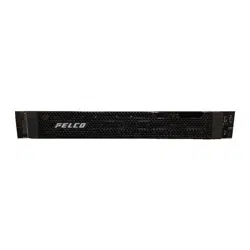Loading ...
Loading ...
Loading ...

VideoXpert® Professional v 3.17 Operations Manual
C6601M-S | 06/22 146
Using Investigation Mode
Investigation mode provides a more detailed interface for synchronized playback and video search in a
single window, making it easier to investigate a scene. From investigation mode, users can also trim and
export video clips from the system’s network video recorder for evidentiary safe keeping.
As you add cameras to the investigation window, the cameras appear in a detailed timeline at the bottom
of the tab populated with recording information for each camera. You can use the timeline to navigate the
composite recording.
In the timeline:
l
A green bar above the recording indicates continuous recording.
l
A blue bar above the recording indicates a motion detection recording.
l
A red bar above the recording indicates an alarm or analytics recording.
l
A thin purple bar under the video recording bar indicates audio recording.
Entering Investigation Mode
Investigation mode provides robust, synchronized playback controls with any number of cells, allowing
users to fully investigate an incident across multiple cameras simultaneously. Investigation mode always
opens in a new tab.
1. Synchronize the cells you want to investigate. To investigate a single cell, do not synchronize any
cells; if there cells are already synchronized, then apply Sync to only the cell that you want to
investigate.
2.
Click in a cell in the Sync group, and then click the Investigate icon ( ).
3. (Optional) Add cameras to the layout. As you add cameras, they will appear in the cells of the
investigation tab, and in the camera list at the bottom of the workspace. A timeline is included in
the playback controls area, indicating the availability of recorded video for all cameras.
Using Investigation to View Video Stored on a Camera's Local Storage
If your camera or video source is recording video locally (using an SD card or in concert with ONVIF
Profile G), and you have the correct permissions, the timeline will display the ; the device tooltip will also
alert you to multiple recording locations. You cannot view video while it is stored on the camera; you must
first push video from the camera to a VideoXpert Storage recorder in order to view a camera’s local
recordings.
Note: Refer to documentation for your camera to enable and setup local recording. The process to
enable and use local recordings may differ by camera model.
Click to open an investigation tab showing the camera’s various recording locations as separate
timelines. On VideoXpert Professional systems, the timelines are labeled as follows:
l
Default Recorder: Video recorded by your VideoXpert Storage recorder. These are the
recordings you would normally see when you playback video.
l
Downloaded from Camera: Video pushed from the camera to the recorder does not overwrite
video already stored on the recorder; the video recorded on the camera and the video recorded on
the VXS recorder coexist. This timeline shows video that has been pushed from the camera to the
recorder. You can only view these recordings when in the multi-recording investigation tab.
l
Camera Storage: Displays thumbnails representing video stored on the camera. You must use
the timeline to create and push video clips to default storage to view it.
Loading ...
Loading ...
Loading ...
